Post-Project Review of Bank1's Enterprise Architecture Implementation
VerifiedAdded on 2022/01/22
|31
|12469
|345
Report
AI Summary
This assignment requires a business analyst to conduct a post-project review of Bank1's Enterprise Architecture Implementation (EAI). The analysis focuses on why the architects failed to secure stakeholder commitment and support for the EAI, utilizing the BABOK knowledge areas of enterprise analysis, elicitation, requirements analysis, and solution assessment and validation. The report examines the architects' perspectives, their interactions within the team, and their interactions with business and technology staff, highlighting the issues that led to the EAI's stalling. The tasks involve analyzing the root causes of the issues and proposing alternative strategies, referencing the BABOK knowledge areas, to ensure future stakeholder commitment and support for similar projects. The case study provides detailed insights into the organizational structure, the architects' roles, and the challenges faced during the EAI implementation, including the role of the Architecture Review Board (ARB) and the impact of the architects' practices on stakeholder engagement. The report is intended to provide a comprehensive understanding of the issues and propose actionable solutions for successful EAI implementation.
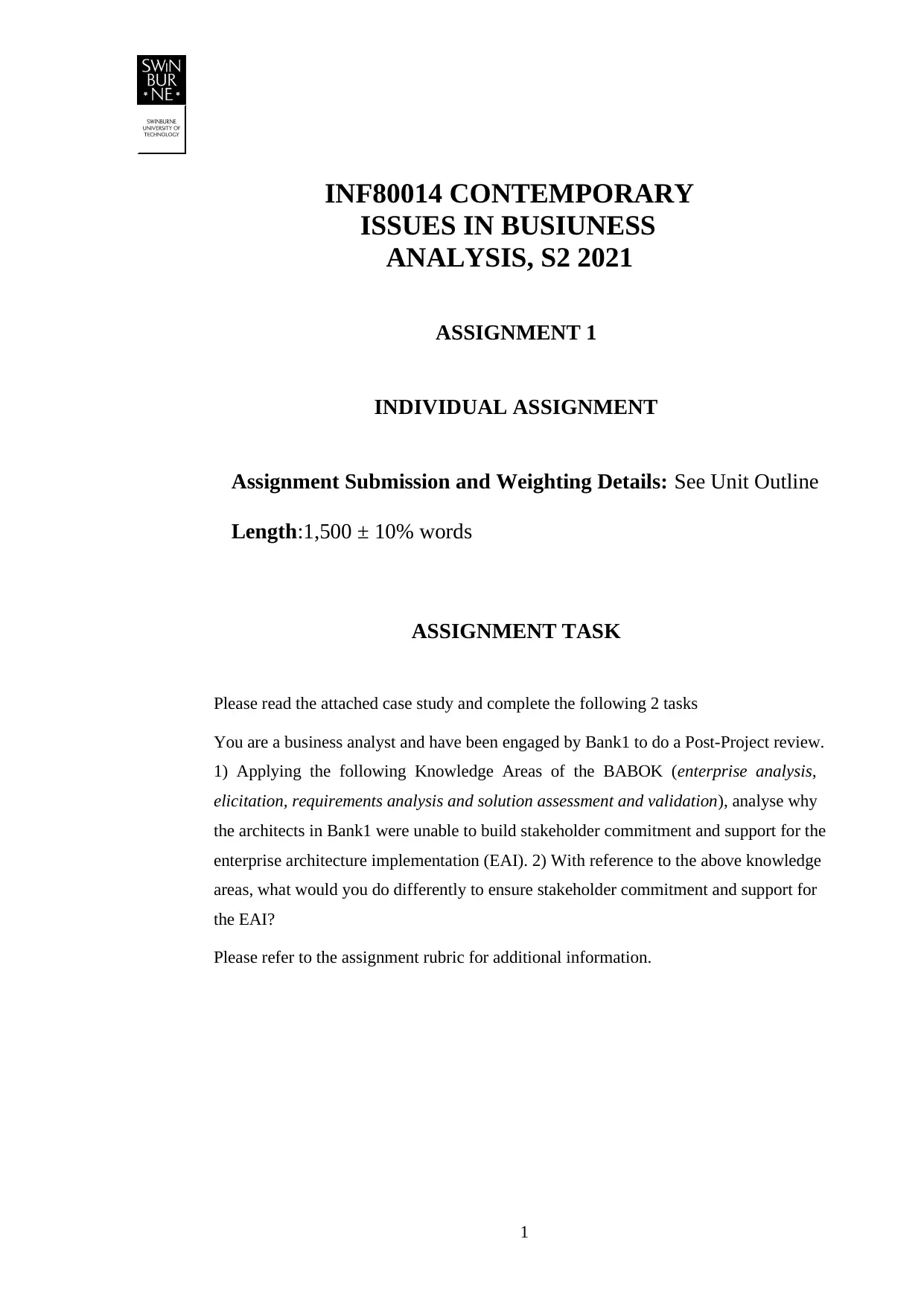
1
INF80014 CONTEMPORARY
ISSUES IN BUSIUNESS
ANALYSIS, S2 2021
ASSIGNMENT 1
INDIVIDUAL ASSIGNMENT
Assignment Submission and Weighting Details: See Unit Outline
Length:1,500 ± 10% words
ASSIGNMENT TASK
Please read the attached case study and complete the following 2 tasks
You are a business analyst and have been engaged by Bank1 to do a Post-Project review.
1) Applying the following Knowledge Areas of the BABOK (enterprise analysis,
elicitation, requirements analysis and solution assessment and validation), analyse why
the architects in Bank1 were unable to build stakeholder commitment and support for the
enterprise architecture implementation (EAI). 2) With reference to the above knowledge
areas, what would you do differently to ensure stakeholder commitment and support for
the EAI?
Please refer to the assignment rubric for additional information.
INF80014 CONTEMPORARY
ISSUES IN BUSIUNESS
ANALYSIS, S2 2021
ASSIGNMENT 1
INDIVIDUAL ASSIGNMENT
Assignment Submission and Weighting Details: See Unit Outline
Length:1,500 ± 10% words
ASSIGNMENT TASK
Please read the attached case study and complete the following 2 tasks
You are a business analyst and have been engaged by Bank1 to do a Post-Project review.
1) Applying the following Knowledge Areas of the BABOK (enterprise analysis,
elicitation, requirements analysis and solution assessment and validation), analyse why
the architects in Bank1 were unable to build stakeholder commitment and support for the
enterprise architecture implementation (EAI). 2) With reference to the above knowledge
areas, what would you do differently to ensure stakeholder commitment and support for
the EAI?
Please refer to the assignment rubric for additional information.
Paraphrase This Document
Need a fresh take? Get an instant paraphrase of this document with our AI Paraphraser
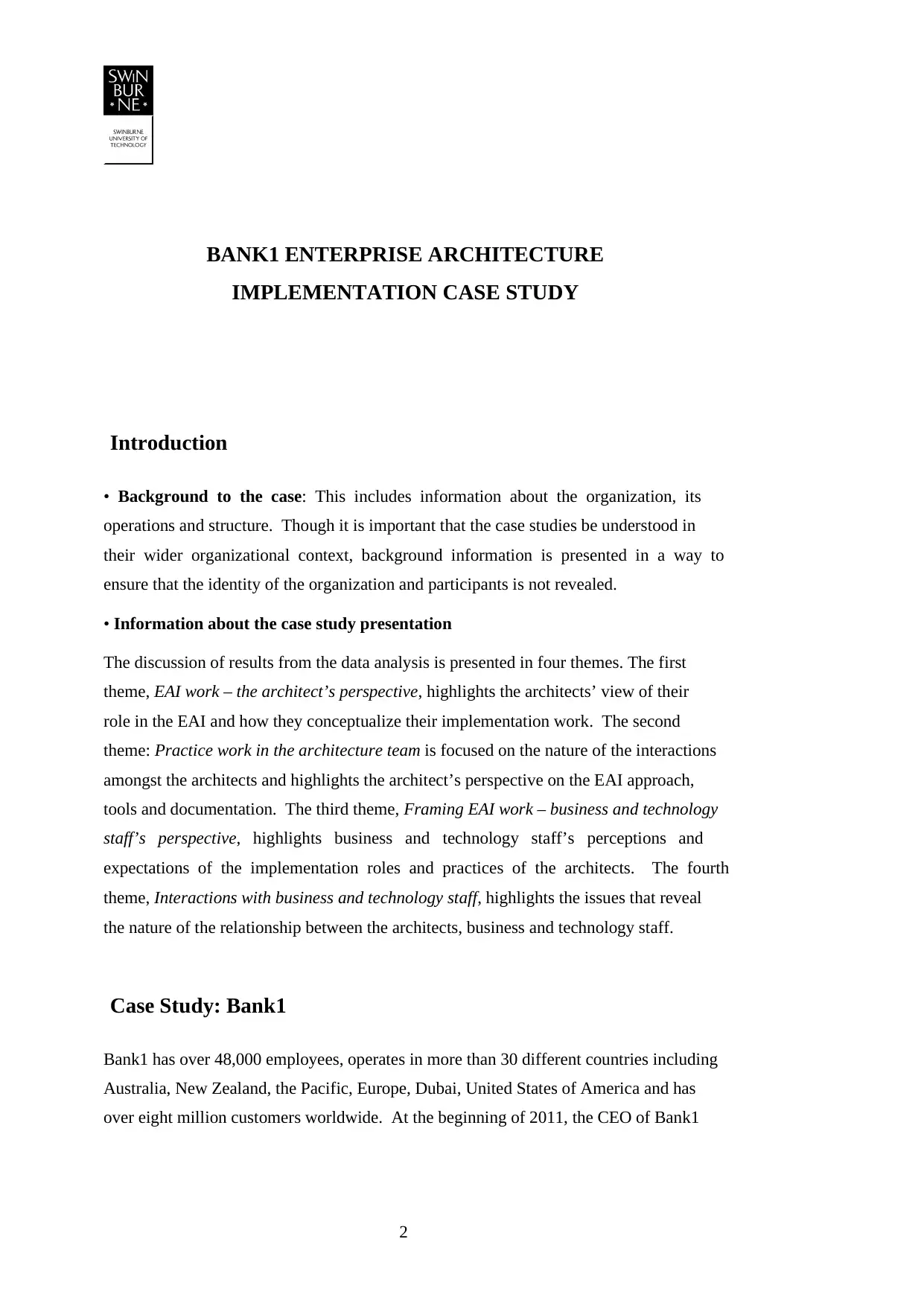
2
BANK1 ENTERPRISE ARCHITECTURE
IMPLEMENTATION CASE STUDY
Introduction
• Background to the case: This includes information about the organization, its
operations and structure. Though it is important that the case studies be understood in
their wider organizational context, background information is presented in a way to
ensure that the identity of the organization and participants is not revealed.
• Information about the case study presentation
The discussion of results from the data analysis is presented in four themes. The first
theme, EAI work – the architect’s perspective, highlights the architects’ view of their
role in the EAI and how they conceptualize their implementation work. The second
theme: Practice work in the architecture team is focused on the nature of the interactions
amongst the architects and highlights the architect’s perspective on the EAI approach,
tools and documentation. The third theme, Framing EAI work – business and technology
staff’s perspective, highlights business and technology staff’s perceptions and
expectations of the implementation roles and practices of the architects. The fourth
theme, Interactions with business and technology staff, highlights the issues that reveal
the nature of the relationship between the architects, business and technology staff.
Case Study: Bank1
Bank1 has over 48,000 employees, operates in more than 30 different countries including
Australia, New Zealand, the Pacific, Europe, Dubai, United States of America and has
over eight million customers worldwide. At the beginning of 2011, the CEO of Bank1
BANK1 ENTERPRISE ARCHITECTURE
IMPLEMENTATION CASE STUDY
Introduction
• Background to the case: This includes information about the organization, its
operations and structure. Though it is important that the case studies be understood in
their wider organizational context, background information is presented in a way to
ensure that the identity of the organization and participants is not revealed.
• Information about the case study presentation
The discussion of results from the data analysis is presented in four themes. The first
theme, EAI work – the architect’s perspective, highlights the architects’ view of their
role in the EAI and how they conceptualize their implementation work. The second
theme: Practice work in the architecture team is focused on the nature of the interactions
amongst the architects and highlights the architect’s perspective on the EAI approach,
tools and documentation. The third theme, Framing EAI work – business and technology
staff’s perspective, highlights business and technology staff’s perceptions and
expectations of the implementation roles and practices of the architects. The fourth
theme, Interactions with business and technology staff, highlights the issues that reveal
the nature of the relationship between the architects, business and technology staff.
Case Study: Bank1
Bank1 has over 48,000 employees, operates in more than 30 different countries including
Australia, New Zealand, the Pacific, Europe, Dubai, United States of America and has
over eight million customers worldwide. At the beginning of 2011, the CEO of Bank1
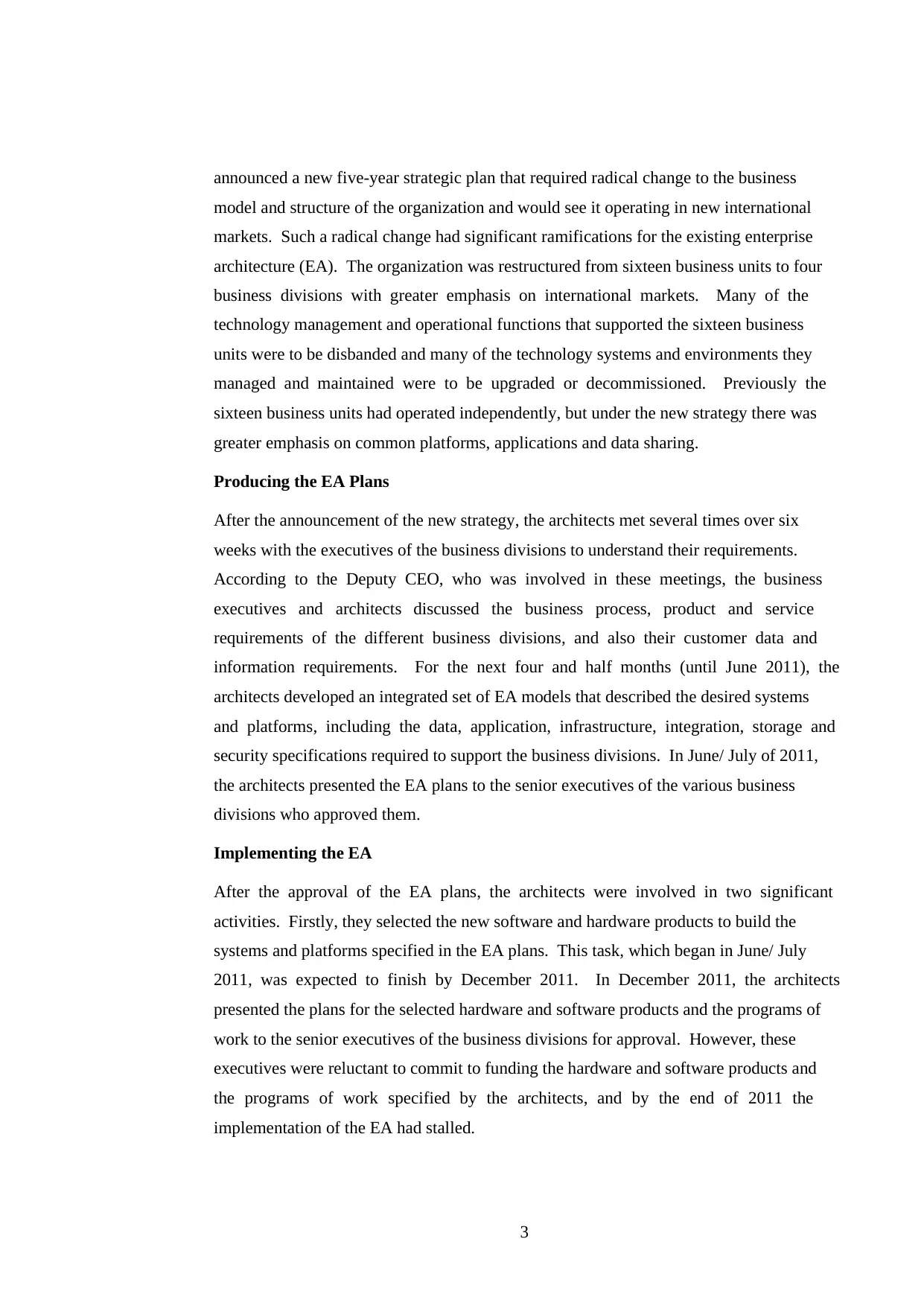
3
announced a new five-year strategic plan that required radical change to the business
model and structure of the organization and would see it operating in new international
markets. Such a radical change had significant ramifications for the existing enterprise
architecture (EA). The organization was restructured from sixteen business units to four
business divisions with greater emphasis on international markets. Many of the
technology management and operational functions that supported the sixteen business
units were to be disbanded and many of the technology systems and environments they
managed and maintained were to be upgraded or decommissioned. Previously the
sixteen business units had operated independently, but under the new strategy there was
greater emphasis on common platforms, applications and data sharing.
Producing the EA Plans
After the announcement of the new strategy, the architects met several times over six
weeks with the executives of the business divisions to understand their requirements.
According to the Deputy CEO, who was involved in these meetings, the business
executives and architects discussed the business process, product and service
requirements of the different business divisions, and also their customer data and
information requirements. For the next four and half months (until June 2011), the
architects developed an integrated set of EA models that described the desired systems
and platforms, including the data, application, infrastructure, integration, storage and
security specifications required to support the business divisions. In June/ July of 2011,
the architects presented the EA plans to the senior executives of the various business
divisions who approved them.
Implementing the EA
After the approval of the EA plans, the architects were involved in two significant
activities. Firstly, they selected the new software and hardware products to build the
systems and platforms specified in the EA plans. This task, which began in June/ July
2011, was expected to finish by December 2011. In December 2011, the architects
presented the plans for the selected hardware and software products and the programs of
work to the senior executives of the business divisions for approval. However, these
executives were reluctant to commit to funding the hardware and software products and
the programs of work specified by the architects, and by the end of 2011 the
implementation of the EA had stalled.
announced a new five-year strategic plan that required radical change to the business
model and structure of the organization and would see it operating in new international
markets. Such a radical change had significant ramifications for the existing enterprise
architecture (EA). The organization was restructured from sixteen business units to four
business divisions with greater emphasis on international markets. Many of the
technology management and operational functions that supported the sixteen business
units were to be disbanded and many of the technology systems and environments they
managed and maintained were to be upgraded or decommissioned. Previously the
sixteen business units had operated independently, but under the new strategy there was
greater emphasis on common platforms, applications and data sharing.
Producing the EA Plans
After the announcement of the new strategy, the architects met several times over six
weeks with the executives of the business divisions to understand their requirements.
According to the Deputy CEO, who was involved in these meetings, the business
executives and architects discussed the business process, product and service
requirements of the different business divisions, and also their customer data and
information requirements. For the next four and half months (until June 2011), the
architects developed an integrated set of EA models that described the desired systems
and platforms, including the data, application, infrastructure, integration, storage and
security specifications required to support the business divisions. In June/ July of 2011,
the architects presented the EA plans to the senior executives of the various business
divisions who approved them.
Implementing the EA
After the approval of the EA plans, the architects were involved in two significant
activities. Firstly, they selected the new software and hardware products to build the
systems and platforms specified in the EA plans. This task, which began in June/ July
2011, was expected to finish by December 2011. In December 2011, the architects
presented the plans for the selected hardware and software products and the programs of
work to the senior executives of the business divisions for approval. However, these
executives were reluctant to commit to funding the hardware and software products and
the programs of work specified by the architects, and by the end of 2011 the
implementation of the EA had stalled.
⊘ This is a preview!⊘
Do you want full access?
Subscribe today to unlock all pages.

Trusted by 1+ million students worldwide
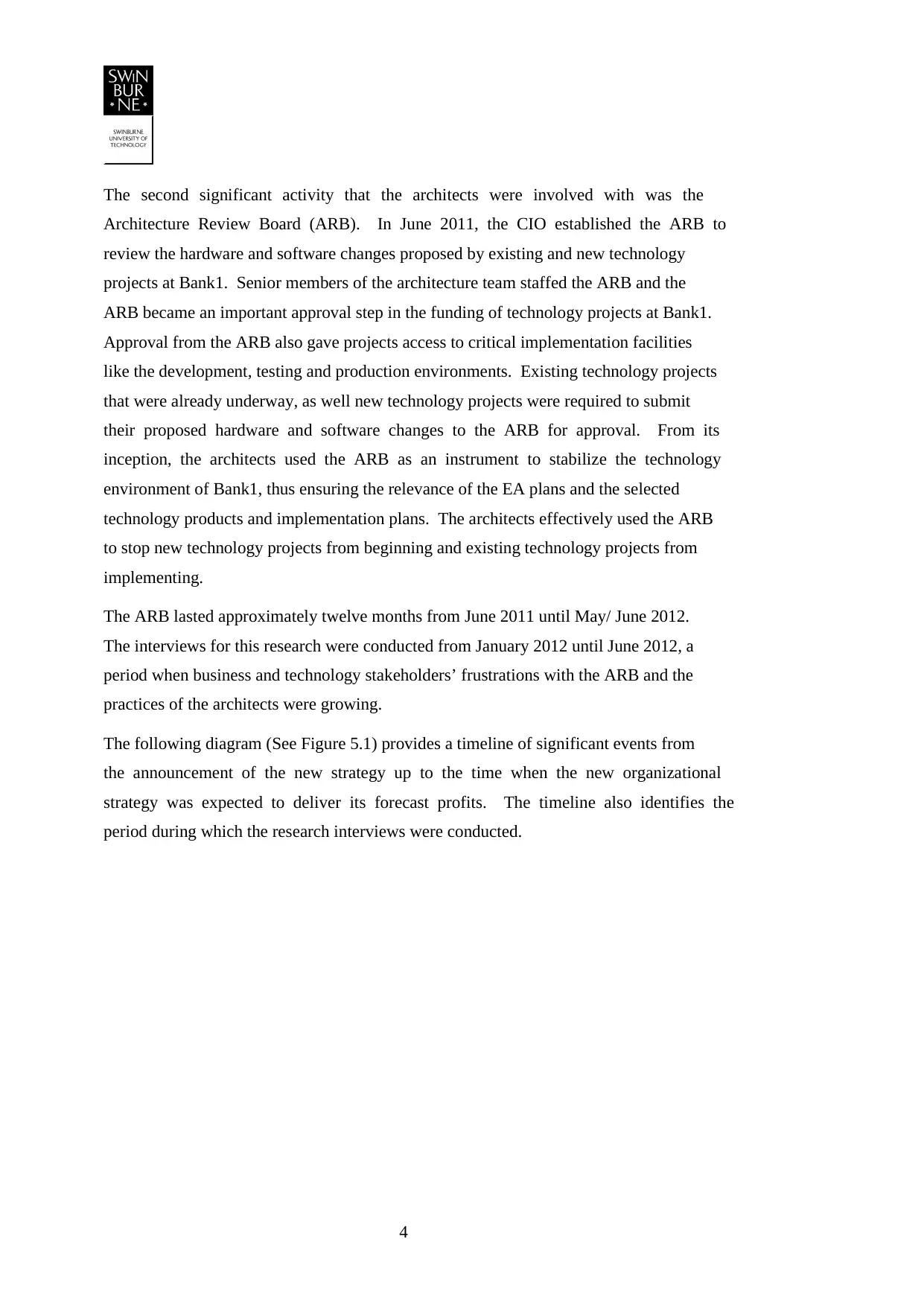
4
The second significant activity that the architects were involved with was the
Architecture Review Board (ARB). In June 2011, the CIO established the ARB to
review the hardware and software changes proposed by existing and new technology
projects at Bank1. Senior members of the architecture team staffed the ARB and the
ARB became an important approval step in the funding of technology projects at Bank1.
Approval from the ARB also gave projects access to critical implementation facilities
like the development, testing and production environments. Existing technology projects
that were already underway, as well new technology projects were required to submit
their proposed hardware and software changes to the ARB for approval. From its
inception, the architects used the ARB as an instrument to stabilize the technology
environment of Bank1, thus ensuring the relevance of the EA plans and the selected
technology products and implementation plans. The architects effectively used the ARB
to stop new technology projects from beginning and existing technology projects from
implementing.
The ARB lasted approximately twelve months from June 2011 until May/ June 2012.
The interviews for this research were conducted from January 2012 until June 2012, a
period when business and technology stakeholders’ frustrations with the ARB and the
practices of the architects were growing.
The following diagram (See Figure 5.1) provides a timeline of significant events from
the announcement of the new strategy up to the time when the new organizational
strategy was expected to deliver its forecast profits. The timeline also identifies the
period during which the research interviews were conducted.
The second significant activity that the architects were involved with was the
Architecture Review Board (ARB). In June 2011, the CIO established the ARB to
review the hardware and software changes proposed by existing and new technology
projects at Bank1. Senior members of the architecture team staffed the ARB and the
ARB became an important approval step in the funding of technology projects at Bank1.
Approval from the ARB also gave projects access to critical implementation facilities
like the development, testing and production environments. Existing technology projects
that were already underway, as well new technology projects were required to submit
their proposed hardware and software changes to the ARB for approval. From its
inception, the architects used the ARB as an instrument to stabilize the technology
environment of Bank1, thus ensuring the relevance of the EA plans and the selected
technology products and implementation plans. The architects effectively used the ARB
to stop new technology projects from beginning and existing technology projects from
implementing.
The ARB lasted approximately twelve months from June 2011 until May/ June 2012.
The interviews for this research were conducted from January 2012 until June 2012, a
period when business and technology stakeholders’ frustrations with the ARB and the
practices of the architects were growing.
The following diagram (See Figure 5.1) provides a timeline of significant events from
the announcement of the new strategy up to the time when the new organizational
strategy was expected to deliver its forecast profits. The timeline also identifies the
period during which the research interviews were conducted.
Paraphrase This Document
Need a fresh take? Get an instant paraphrase of this document with our AI Paraphraser
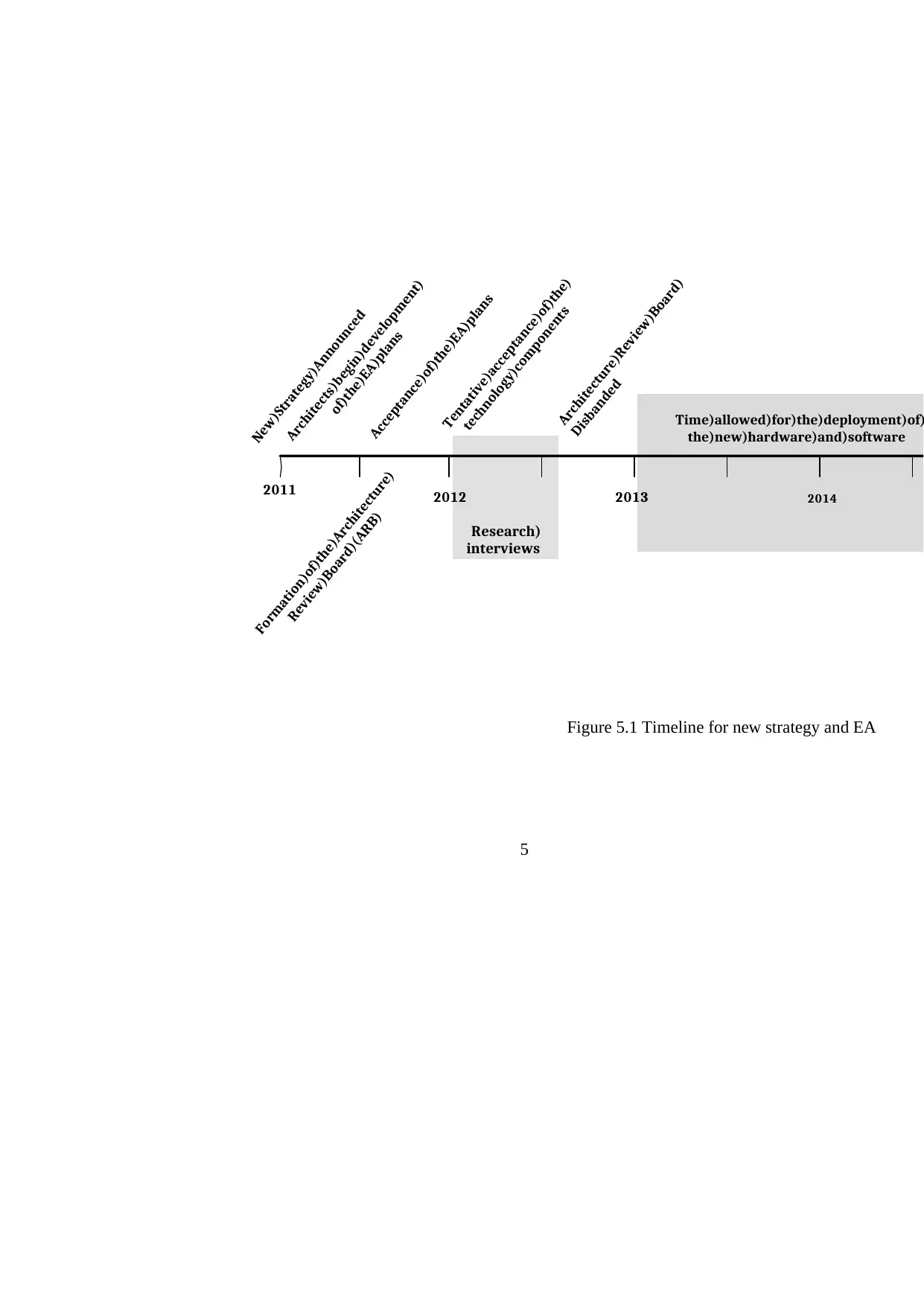
5
Figure 5.1 Timeline for new strategy and EA
2011 2012 2013
New)Strategy)Announced
Formation)of)the)Architecture)
Review)Board)(ARB)
Architecture)Review)Board)
Disbanded
2014
Acceptance)of)the)EA)plans
Architects)begin)development)
of)the)EA)plans
Tentative)acceptance)of)the)
technology)components
Research)
interviews
Time)allowed)for)the)deployment)of)
the)new)hardware)and)software
Figure 5.1 Timeline for new strategy and EA
2011 2012 2013
New)Strategy)Announced
Formation)of)the)Architecture)
Review)Board)(ARB)
Architecture)Review)Board)
Disbanded
2014
Acceptance)of)the)EA)plans
Architects)begin)development)
of)the)EA)plans
Tentative)acceptance)of)the)
technology)components
Research)
interviews
Time)allowed)for)the)deployment)of)
the)new)hardware)and)software
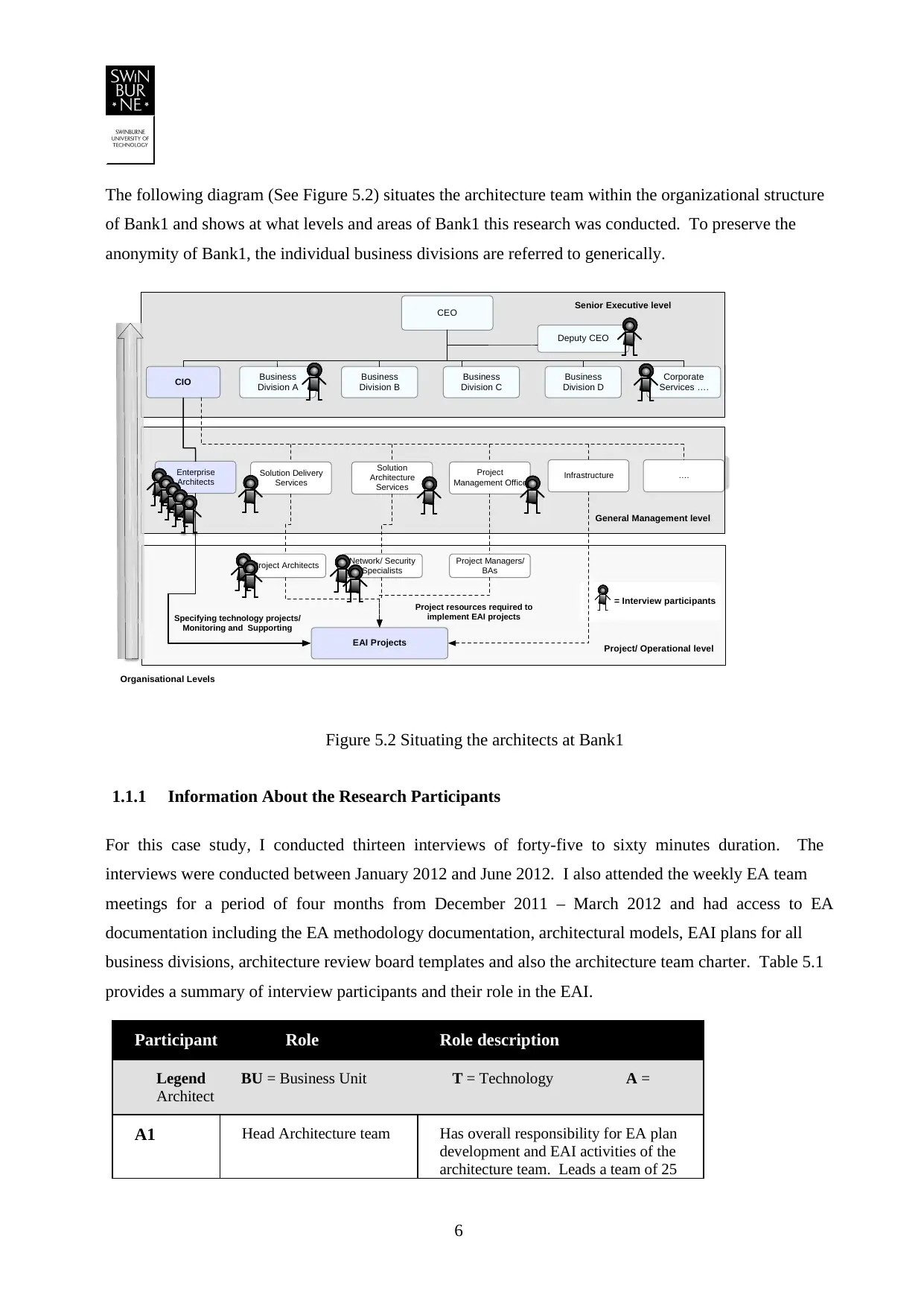
6
The following diagram (See Figure 5.2) situates the architecture team within the organizational structure
of Bank1 and shows at what levels and areas of Bank1 this research was conducted. To preserve the
anonymity of Bank1, the individual business divisions are referred to generically.
Figure 5.2 Situating the architects at Bank1
1.1.1 Information About the Research Participants
For this case study, I conducted thirteen interviews of forty-five to sixty minutes duration. The
interviews were conducted between January 2012 and June 2012. I also attended the weekly EA team
meetings for a period of four months from December 2011 – March 2012 and had access to EA
documentation including the EA methodology documentation, architectural models, EAI plans for all
business divisions, architecture review board templates and also the architecture team charter. Table 5.1
provides a summary of interview participants and their role in the EAI.
Participant Role Role description
Legend BU = Business Unit T = Technology A =
Architect
A1 Head Architecture team Has overall responsibility for EA plan
development and EAI activities of the
architecture team. Leads a team of 25
CEO
CIO Business
Division A
Deputy CEO
Enterprise
Architects
Corporate
Services ….
Solution Delivery
Services
Solution
Architecture
Services
EAI Projects
Organisational Levels
Project
Management Office
Business
Division B
Business
Division C
Business
Division D
Specifying technology projects/
Monitoring and Supporting
Project resources required to
implement EAI projects
Senior Executive level
General Management level
Project/ Operational level
Project Architects Network/ Security
Specialists
Project Managers/
BAs
= Interview participants
Infrastructure ….
The following diagram (See Figure 5.2) situates the architecture team within the organizational structure
of Bank1 and shows at what levels and areas of Bank1 this research was conducted. To preserve the
anonymity of Bank1, the individual business divisions are referred to generically.
Figure 5.2 Situating the architects at Bank1
1.1.1 Information About the Research Participants
For this case study, I conducted thirteen interviews of forty-five to sixty minutes duration. The
interviews were conducted between January 2012 and June 2012. I also attended the weekly EA team
meetings for a period of four months from December 2011 – March 2012 and had access to EA
documentation including the EA methodology documentation, architectural models, EAI plans for all
business divisions, architecture review board templates and also the architecture team charter. Table 5.1
provides a summary of interview participants and their role in the EAI.
Participant Role Role description
Legend BU = Business Unit T = Technology A =
Architect
A1 Head Architecture team Has overall responsibility for EA plan
development and EAI activities of the
architecture team. Leads a team of 25
CEO
CIO Business
Division A
Deputy CEO
Enterprise
Architects
Corporate
Services ….
Solution Delivery
Services
Solution
Architecture
Services
EAI Projects
Organisational Levels
Project
Management Office
Business
Division B
Business
Division C
Business
Division D
Specifying technology projects/
Monitoring and Supporting
Project resources required to
implement EAI projects
Senior Executive level
General Management level
Project/ Operational level
Project Architects Network/ Security
Specialists
Project Managers/
BAs
= Interview participants
Infrastructure ….
⊘ This is a preview!⊘
Do you want full access?
Subscribe today to unlock all pages.

Trusted by 1+ million students worldwide
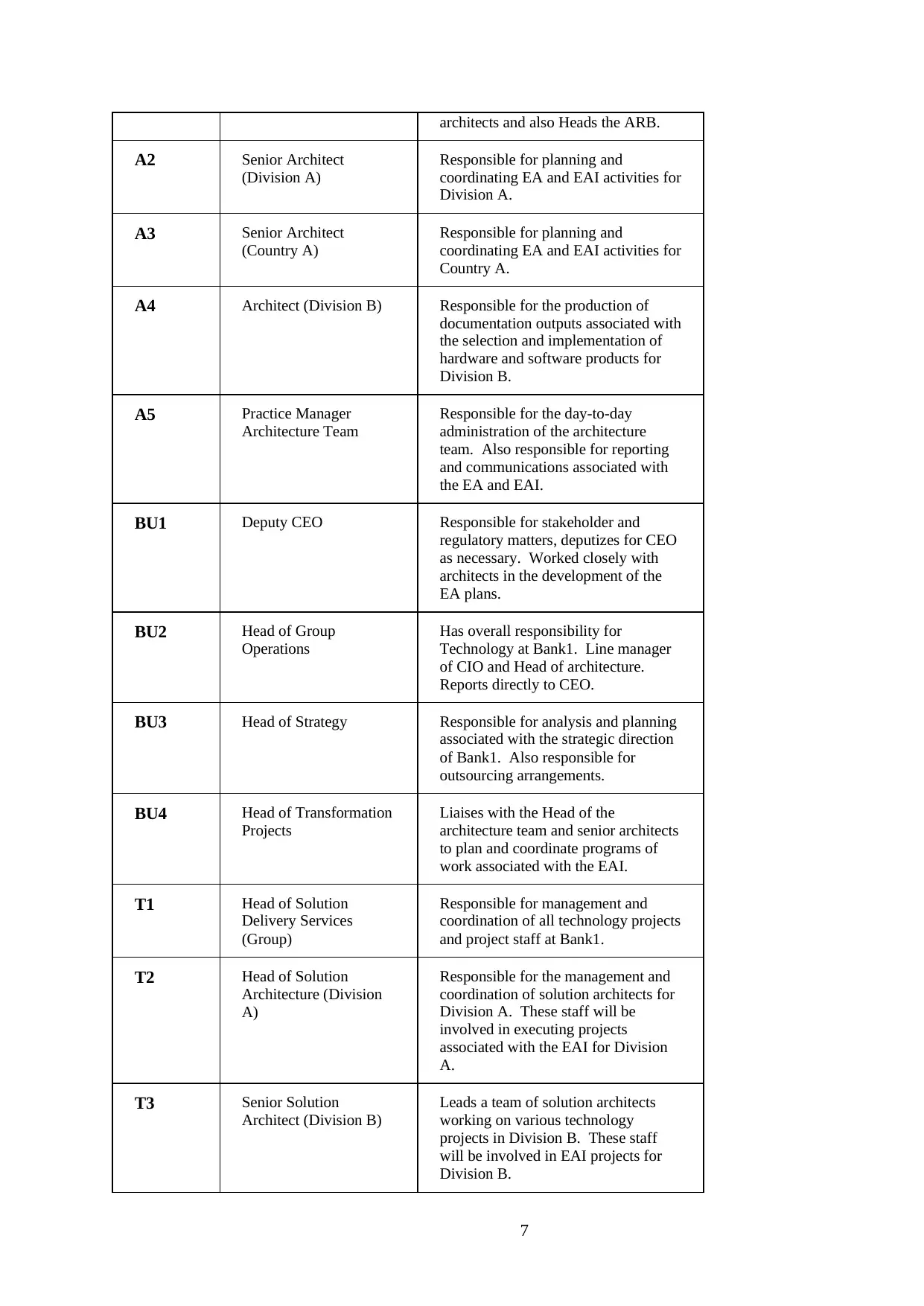
7
architects and also Heads the ARB.
A2 Senior Architect
(Division A)
Responsible for planning and
coordinating EA and EAI activities for
Division A.
A3 Senior Architect
(Country A)
Responsible for planning and
coordinating EA and EAI activities for
Country A.
A4 Architect (Division B) Responsible for the production of
documentation outputs associated with
the selection and implementation of
hardware and software products for
Division B.
A5 Practice Manager
Architecture Team
Responsible for the day-to-day
administration of the architecture
team. Also responsible for reporting
and communications associated with
the EA and EAI.
BU1 Deputy CEO Responsible for stakeholder and
regulatory matters, deputizes for CEO
as necessary. Worked closely with
architects in the development of the
EA plans.
BU2 Head of Group
Operations
Has overall responsibility for
Technology at Bank1. Line manager
of CIO and Head of architecture.
Reports directly to CEO.
BU3 Head of Strategy Responsible for analysis and planning
associated with the strategic direction
of Bank1. Also responsible for
outsourcing arrangements.
BU4 Head of Transformation
Projects
Liaises with the Head of the
architecture team and senior architects
to plan and coordinate programs of
work associated with the EAI.
T1 Head of Solution
Delivery Services
(Group)
Responsible for management and
coordination of all technology projects
and project staff at Bank1.
T2 Head of Solution
Architecture (Division
A)
Responsible for the management and
coordination of solution architects for
Division A. These staff will be
involved in executing projects
associated with the EAI for Division
A.
T3 Senior Solution
Architect (Division B)
Leads a team of solution architects
working on various technology
projects in Division B. These staff
will be involved in EAI projects for
Division B.
architects and also Heads the ARB.
A2 Senior Architect
(Division A)
Responsible for planning and
coordinating EA and EAI activities for
Division A.
A3 Senior Architect
(Country A)
Responsible for planning and
coordinating EA and EAI activities for
Country A.
A4 Architect (Division B) Responsible for the production of
documentation outputs associated with
the selection and implementation of
hardware and software products for
Division B.
A5 Practice Manager
Architecture Team
Responsible for the day-to-day
administration of the architecture
team. Also responsible for reporting
and communications associated with
the EA and EAI.
BU1 Deputy CEO Responsible for stakeholder and
regulatory matters, deputizes for CEO
as necessary. Worked closely with
architects in the development of the
EA plans.
BU2 Head of Group
Operations
Has overall responsibility for
Technology at Bank1. Line manager
of CIO and Head of architecture.
Reports directly to CEO.
BU3 Head of Strategy Responsible for analysis and planning
associated with the strategic direction
of Bank1. Also responsible for
outsourcing arrangements.
BU4 Head of Transformation
Projects
Liaises with the Head of the
architecture team and senior architects
to plan and coordinate programs of
work associated with the EAI.
T1 Head of Solution
Delivery Services
(Group)
Responsible for management and
coordination of all technology projects
and project staff at Bank1.
T2 Head of Solution
Architecture (Division
A)
Responsible for the management and
coordination of solution architects for
Division A. These staff will be
involved in executing projects
associated with the EAI for Division
A.
T3 Senior Solution
Architect (Division B)
Leads a team of solution architects
working on various technology
projects in Division B. These staff
will be involved in EAI projects for
Division B.
Paraphrase This Document
Need a fresh take? Get an instant paraphrase of this document with our AI Paraphraser
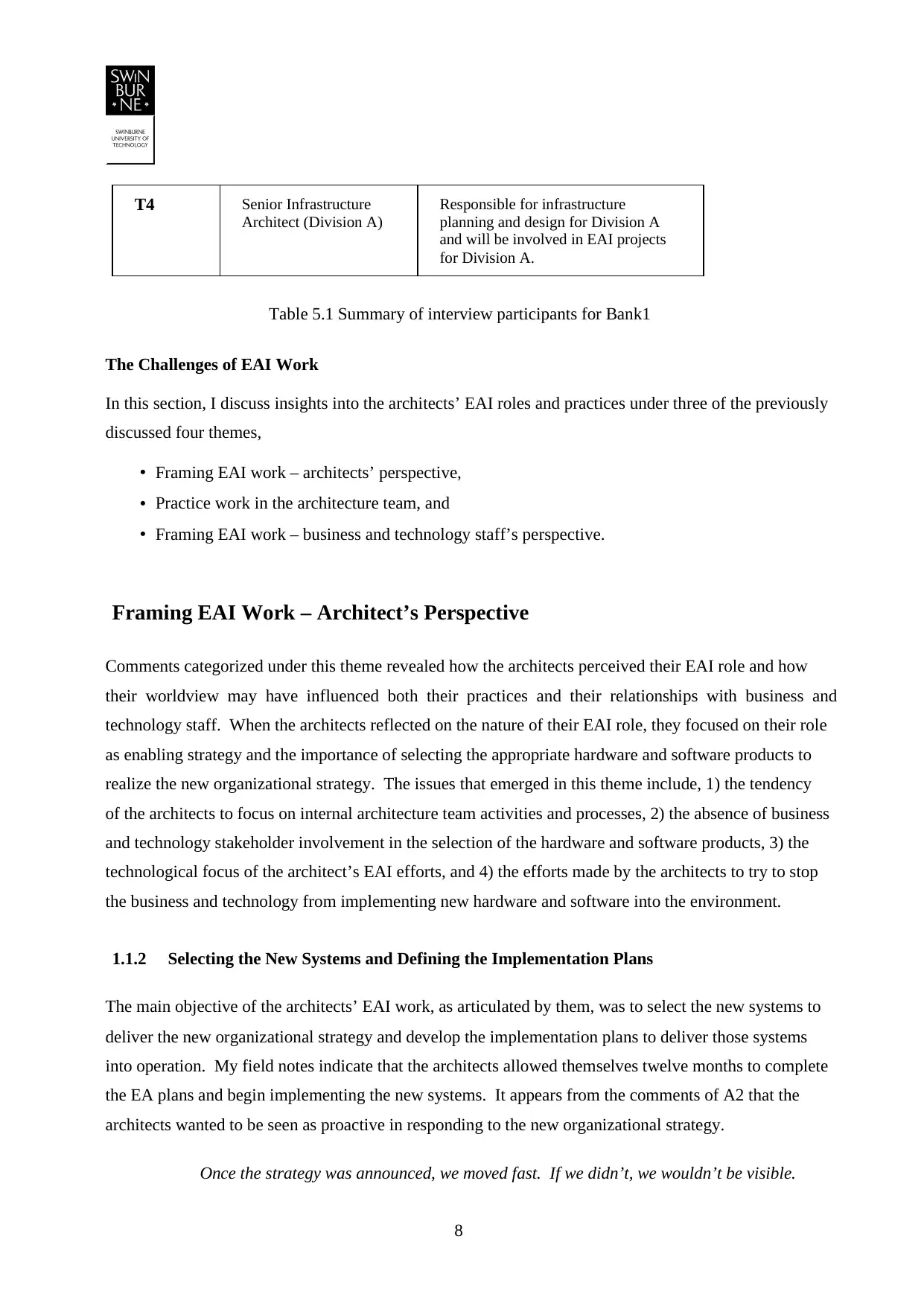
8
T4 Senior Infrastructure
Architect (Division A)
Responsible for infrastructure
planning and design for Division A
and will be involved in EAI projects
for Division A.
Table 5.1 Summary of interview participants for Bank1
The Challenges of EAI Work
In this section, I discuss insights into the architects’ EAI roles and practices under three of the previously
discussed four themes,
• Framing EAI work – architects’ perspective,
• Practice work in the architecture team, and
• Framing EAI work – business and technology staff’s perspective.
Framing EAI Work – Architect’s Perspective
Comments categorized under this theme revealed how the architects perceived their EAI role and how
their worldview may have influenced both their practices and their relationships with business and
technology staff. When the architects reflected on the nature of their EAI role, they focused on their role
as enabling strategy and the importance of selecting the appropriate hardware and software products to
realize the new organizational strategy. The issues that emerged in this theme include, 1) the tendency
of the architects to focus on internal architecture team activities and processes, 2) the absence of business
and technology stakeholder involvement in the selection of the hardware and software products, 3) the
technological focus of the architect’s EAI efforts, and 4) the efforts made by the architects to try to stop
the business and technology from implementing new hardware and software into the environment.
1.1.2 Selecting the New Systems and Defining the Implementation Plans
The main objective of the architects’ EAI work, as articulated by them, was to select the new systems to
deliver the new organizational strategy and develop the implementation plans to deliver those systems
into operation. My field notes indicate that the architects allowed themselves twelve months to complete
the EA plans and begin implementing the new systems. It appears from the comments of A2 that the
architects wanted to be seen as proactive in responding to the new organizational strategy.
Once the strategy was announced, we moved fast. If we didn’t, we wouldn’t be visible.
T4 Senior Infrastructure
Architect (Division A)
Responsible for infrastructure
planning and design for Division A
and will be involved in EAI projects
for Division A.
Table 5.1 Summary of interview participants for Bank1
The Challenges of EAI Work
In this section, I discuss insights into the architects’ EAI roles and practices under three of the previously
discussed four themes,
• Framing EAI work – architects’ perspective,
• Practice work in the architecture team, and
• Framing EAI work – business and technology staff’s perspective.
Framing EAI Work – Architect’s Perspective
Comments categorized under this theme revealed how the architects perceived their EAI role and how
their worldview may have influenced both their practices and their relationships with business and
technology staff. When the architects reflected on the nature of their EAI role, they focused on their role
as enabling strategy and the importance of selecting the appropriate hardware and software products to
realize the new organizational strategy. The issues that emerged in this theme include, 1) the tendency
of the architects to focus on internal architecture team activities and processes, 2) the absence of business
and technology stakeholder involvement in the selection of the hardware and software products, 3) the
technological focus of the architect’s EAI efforts, and 4) the efforts made by the architects to try to stop
the business and technology from implementing new hardware and software into the environment.
1.1.2 Selecting the New Systems and Defining the Implementation Plans
The main objective of the architects’ EAI work, as articulated by them, was to select the new systems to
deliver the new organizational strategy and develop the implementation plans to deliver those systems
into operation. My field notes indicate that the architects allowed themselves twelve months to complete
the EA plans and begin implementing the new systems. It appears from the comments of A2 that the
architects wanted to be seen as proactive in responding to the new organizational strategy.
Once the strategy was announced, we moved fast. If we didn’t, we wouldn’t be visible.
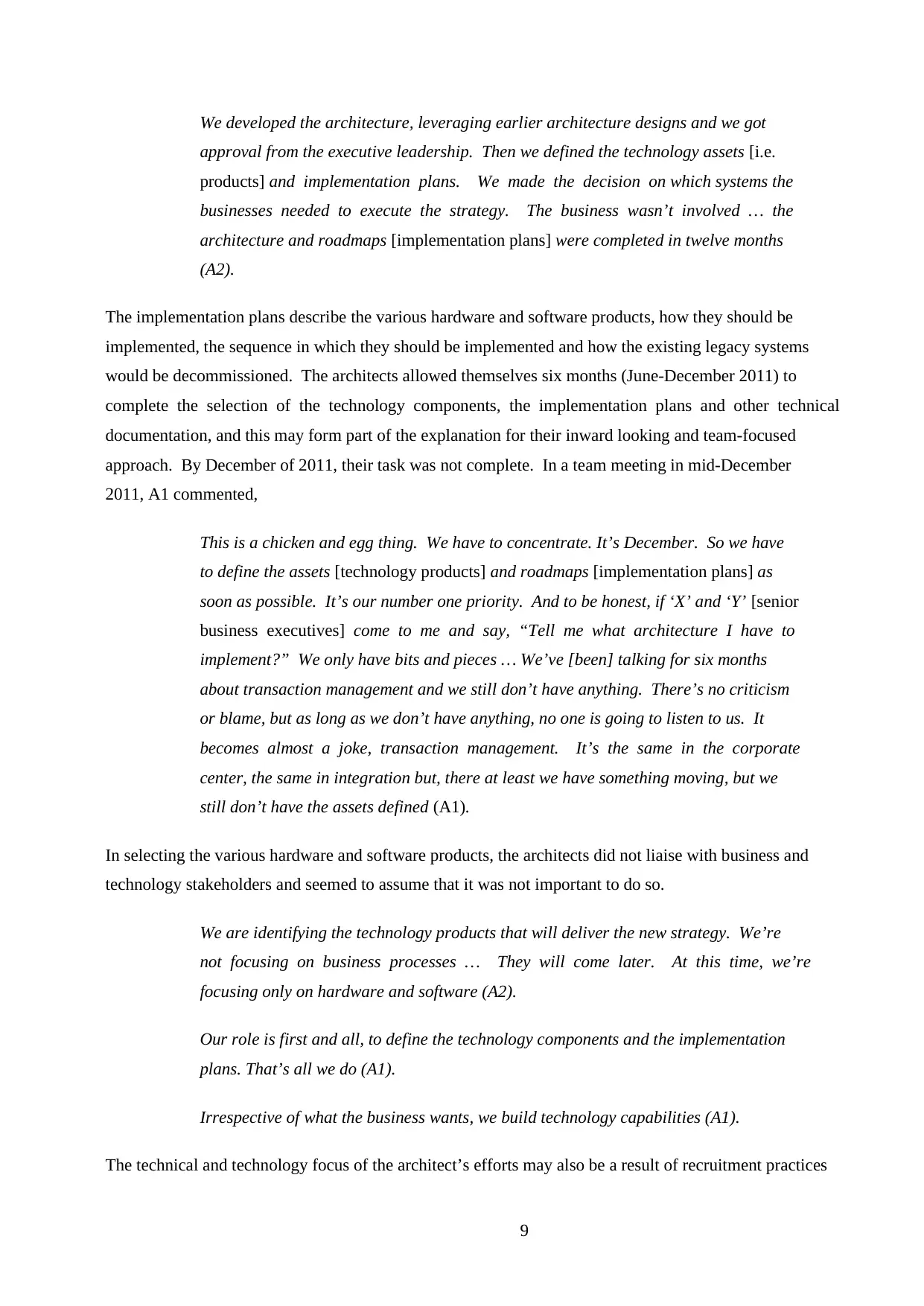
9
We developed the architecture, leveraging earlier architecture designs and we got
approval from the executive leadership. Then we defined the technology assets [i.e.
products] and implementation plans. We made the decision on which systems the
businesses needed to execute the strategy. The business wasn’t involved … the
architecture and roadmaps [implementation plans] were completed in twelve months
(A2).
The implementation plans describe the various hardware and software products, how they should be
implemented, the sequence in which they should be implemented and how the existing legacy systems
would be decommissioned. The architects allowed themselves six months (June-December 2011) to
complete the selection of the technology components, the implementation plans and other technical
documentation, and this may form part of the explanation for their inward looking and team-focused
approach. By December of 2011, their task was not complete. In a team meeting in mid-December
2011, A1 commented,
This is a chicken and egg thing. We have to concentrate. It’s December. So we have
to define the assets [technology products] and roadmaps [implementation plans] as
soon as possible. It’s our number one priority. And to be honest, if ‘X’ and ‘Y’ [senior
business executives] come to me and say, “Tell me what architecture I have to
implement?” We only have bits and pieces … We’ve [been] talking for six months
about transaction management and we still don’t have anything. There’s no criticism
or blame, but as long as we don’t have anything, no one is going to listen to us. It
becomes almost a joke, transaction management. It’s the same in the corporate
center, the same in integration but, there at least we have something moving, but we
still don’t have the assets defined (A1).
In selecting the various hardware and software products, the architects did not liaise with business and
technology stakeholders and seemed to assume that it was not important to do so.
We are identifying the technology products that will deliver the new strategy. We’re
not focusing on business processes … They will come later. At this time, we’re
focusing only on hardware and software (A2).
Our role is first and all, to define the technology components and the implementation
plans. That’s all we do (A1).
Irrespective of what the business wants, we build technology capabilities (A1).
The technical and technology focus of the architect’s efforts may also be a result of recruitment practices
We developed the architecture, leveraging earlier architecture designs and we got
approval from the executive leadership. Then we defined the technology assets [i.e.
products] and implementation plans. We made the decision on which systems the
businesses needed to execute the strategy. The business wasn’t involved … the
architecture and roadmaps [implementation plans] were completed in twelve months
(A2).
The implementation plans describe the various hardware and software products, how they should be
implemented, the sequence in which they should be implemented and how the existing legacy systems
would be decommissioned. The architects allowed themselves six months (June-December 2011) to
complete the selection of the technology components, the implementation plans and other technical
documentation, and this may form part of the explanation for their inward looking and team-focused
approach. By December of 2011, their task was not complete. In a team meeting in mid-December
2011, A1 commented,
This is a chicken and egg thing. We have to concentrate. It’s December. So we have
to define the assets [technology products] and roadmaps [implementation plans] as
soon as possible. It’s our number one priority. And to be honest, if ‘X’ and ‘Y’ [senior
business executives] come to me and say, “Tell me what architecture I have to
implement?” We only have bits and pieces … We’ve [been] talking for six months
about transaction management and we still don’t have anything. There’s no criticism
or blame, but as long as we don’t have anything, no one is going to listen to us. It
becomes almost a joke, transaction management. It’s the same in the corporate
center, the same in integration but, there at least we have something moving, but we
still don’t have the assets defined (A1).
In selecting the various hardware and software products, the architects did not liaise with business and
technology stakeholders and seemed to assume that it was not important to do so.
We are identifying the technology products that will deliver the new strategy. We’re
not focusing on business processes … They will come later. At this time, we’re
focusing only on hardware and software (A2).
Our role is first and all, to define the technology components and the implementation
plans. That’s all we do (A1).
Irrespective of what the business wants, we build technology capabilities (A1).
The technical and technology focus of the architect’s efforts may also be a result of recruitment practices
⊘ This is a preview!⊘
Do you want full access?
Subscribe today to unlock all pages.

Trusted by 1+ million students worldwide
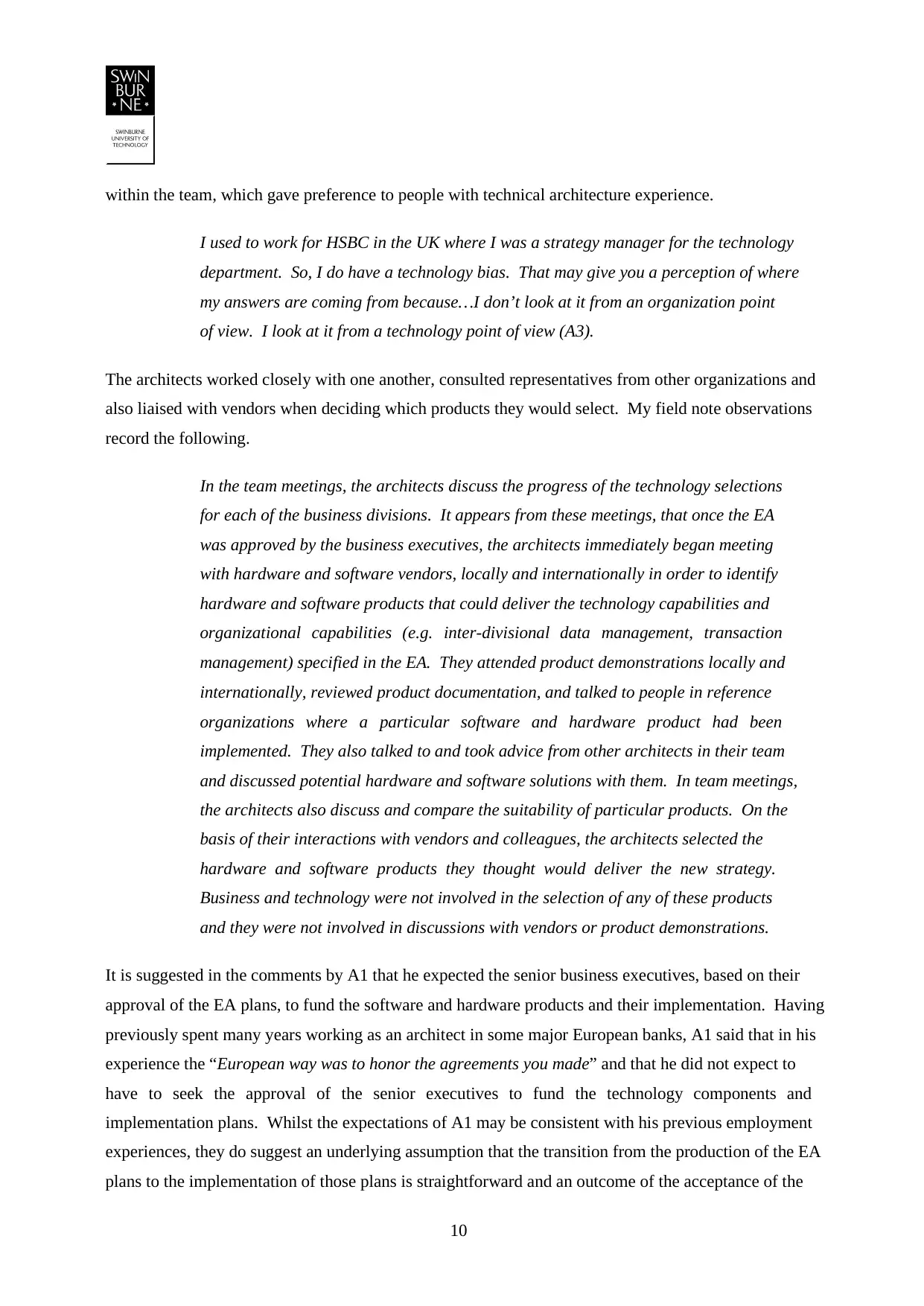
10
within the team, which gave preference to people with technical architecture experience.
I used to work for HSBC in the UK where I was a strategy manager for the technology
department. So, I do have a technology bias. That may give you a perception of where
my answers are coming from because…I don’t look at it from an organization point
of view. I look at it from a technology point of view (A3).
The architects worked closely with one another, consulted representatives from other organizations and
also liaised with vendors when deciding which products they would select. My field note observations
record the following.
In the team meetings, the architects discuss the progress of the technology selections
for each of the business divisions. It appears from these meetings, that once the EA
was approved by the business executives, the architects immediately began meeting
with hardware and software vendors, locally and internationally in order to identify
hardware and software products that could deliver the technology capabilities and
organizational capabilities (e.g. inter-divisional data management, transaction
management) specified in the EA. They attended product demonstrations locally and
internationally, reviewed product documentation, and talked to people in reference
organizations where a particular software and hardware product had been
implemented. They also talked to and took advice from other architects in their team
and discussed potential hardware and software solutions with them. In team meetings,
the architects also discuss and compare the suitability of particular products. On the
basis of their interactions with vendors and colleagues, the architects selected the
hardware and software products they thought would deliver the new strategy.
Business and technology were not involved in the selection of any of these products
and they were not involved in discussions with vendors or product demonstrations.
It is suggested in the comments by A1 that he expected the senior business executives, based on their
approval of the EA plans, to fund the software and hardware products and their implementation. Having
previously spent many years working as an architect in some major European banks, A1 said that in his
experience the “European way was to honor the agreements you made” and that he did not expect to
have to seek the approval of the senior executives to fund the technology components and
implementation plans. Whilst the expectations of A1 may be consistent with his previous employment
experiences, they do suggest an underlying assumption that the transition from the production of the EA
plans to the implementation of those plans is straightforward and an outcome of the acceptance of the
within the team, which gave preference to people with technical architecture experience.
I used to work for HSBC in the UK where I was a strategy manager for the technology
department. So, I do have a technology bias. That may give you a perception of where
my answers are coming from because…I don’t look at it from an organization point
of view. I look at it from a technology point of view (A3).
The architects worked closely with one another, consulted representatives from other organizations and
also liaised with vendors when deciding which products they would select. My field note observations
record the following.
In the team meetings, the architects discuss the progress of the technology selections
for each of the business divisions. It appears from these meetings, that once the EA
was approved by the business executives, the architects immediately began meeting
with hardware and software vendors, locally and internationally in order to identify
hardware and software products that could deliver the technology capabilities and
organizational capabilities (e.g. inter-divisional data management, transaction
management) specified in the EA. They attended product demonstrations locally and
internationally, reviewed product documentation, and talked to people in reference
organizations where a particular software and hardware product had been
implemented. They also talked to and took advice from other architects in their team
and discussed potential hardware and software solutions with them. In team meetings,
the architects also discuss and compare the suitability of particular products. On the
basis of their interactions with vendors and colleagues, the architects selected the
hardware and software products they thought would deliver the new strategy.
Business and technology were not involved in the selection of any of these products
and they were not involved in discussions with vendors or product demonstrations.
It is suggested in the comments by A1 that he expected the senior business executives, based on their
approval of the EA plans, to fund the software and hardware products and their implementation. Having
previously spent many years working as an architect in some major European banks, A1 said that in his
experience the “European way was to honor the agreements you made” and that he did not expect to
have to seek the approval of the senior executives to fund the technology components and
implementation plans. Whilst the expectations of A1 may be consistent with his previous employment
experiences, they do suggest an underlying assumption that the transition from the production of the EA
plans to the implementation of those plans is straightforward and an outcome of the acceptance of the
Paraphrase This Document
Need a fresh take? Get an instant paraphrase of this document with our AI Paraphraser
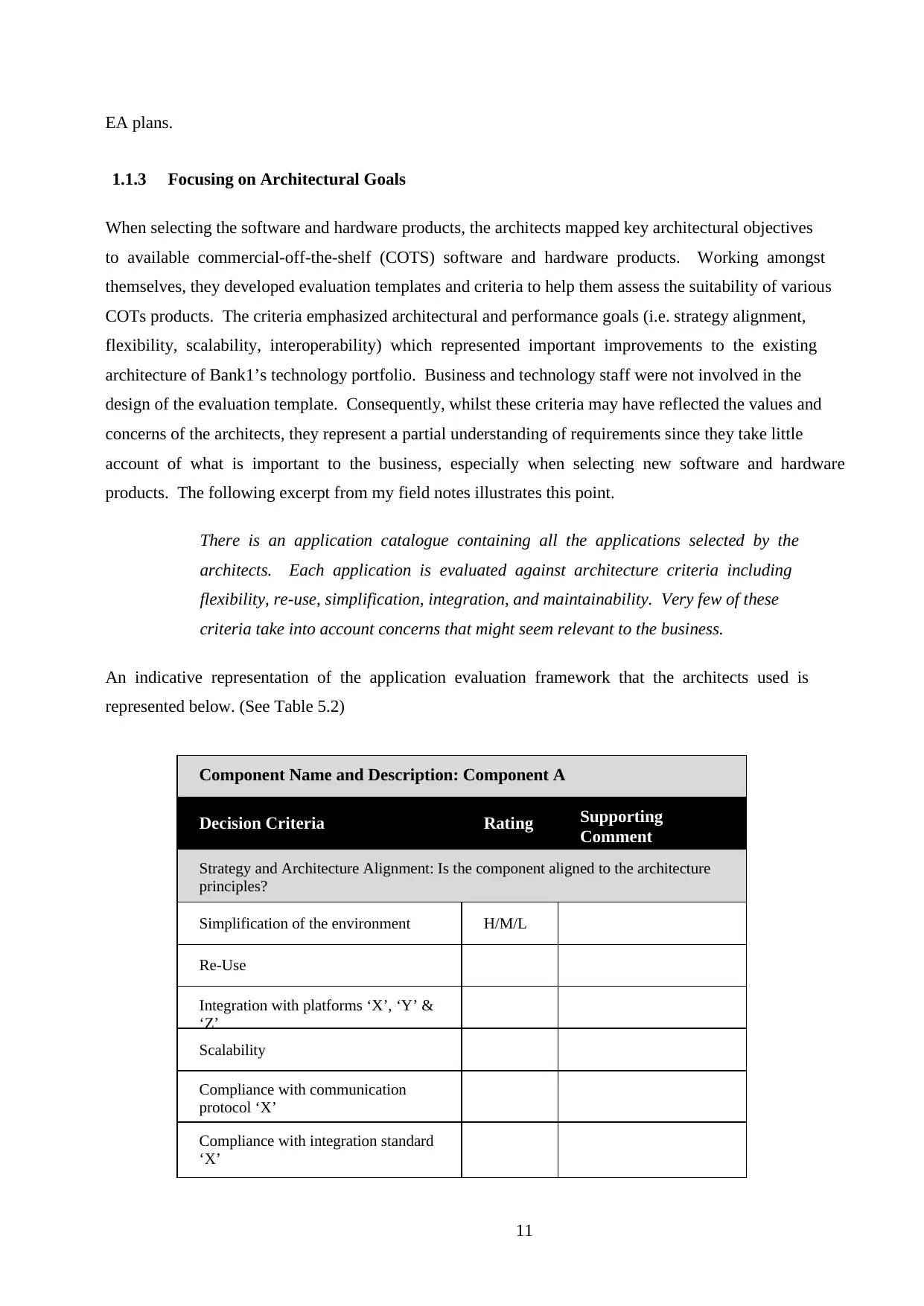
11
EA plans.
1.1.3 Focusing on Architectural Goals
When selecting the software and hardware products, the architects mapped key architectural objectives
to available commercial-off-the-shelf (COTS) software and hardware products. Working amongst
themselves, they developed evaluation templates and criteria to help them assess the suitability of various
COTs products. The criteria emphasized architectural and performance goals (i.e. strategy alignment,
flexibility, scalability, interoperability) which represented important improvements to the existing
architecture of Bank1’s technology portfolio. Business and technology staff were not involved in the
design of the evaluation template. Consequently, whilst these criteria may have reflected the values and
concerns of the architects, they represent a partial understanding of requirements since they take little
account of what is important to the business, especially when selecting new software and hardware
products. The following excerpt from my field notes illustrates this point.
There is an application catalogue containing all the applications selected by the
architects. Each application is evaluated against architecture criteria including
flexibility, re-use, simplification, integration, and maintainability. Very few of these
criteria take into account concerns that might seem relevant to the business.
An indicative representation of the application evaluation framework that the architects used is
represented below. (See Table 5.2)
Component Name and Description: Component A
Decision Criteria Rating Supporting
Comment
Strategy and Architecture Alignment: Is the component aligned to the architecture
principles?
Simplification of the environment H/M/L
Re-Use
Integration with platforms ‘X’, ‘Y’ &
‘Z’
Scalability
Compliance with communication
protocol ‘X’
Compliance with integration standard
‘X’
EA plans.
1.1.3 Focusing on Architectural Goals
When selecting the software and hardware products, the architects mapped key architectural objectives
to available commercial-off-the-shelf (COTS) software and hardware products. Working amongst
themselves, they developed evaluation templates and criteria to help them assess the suitability of various
COTs products. The criteria emphasized architectural and performance goals (i.e. strategy alignment,
flexibility, scalability, interoperability) which represented important improvements to the existing
architecture of Bank1’s technology portfolio. Business and technology staff were not involved in the
design of the evaluation template. Consequently, whilst these criteria may have reflected the values and
concerns of the architects, they represent a partial understanding of requirements since they take little
account of what is important to the business, especially when selecting new software and hardware
products. The following excerpt from my field notes illustrates this point.
There is an application catalogue containing all the applications selected by the
architects. Each application is evaluated against architecture criteria including
flexibility, re-use, simplification, integration, and maintainability. Very few of these
criteria take into account concerns that might seem relevant to the business.
An indicative representation of the application evaluation framework that the architects used is
represented below. (See Table 5.2)
Component Name and Description: Component A
Decision Criteria Rating Supporting
Comment
Strategy and Architecture Alignment: Is the component aligned to the architecture
principles?
Simplification of the environment H/M/L
Re-Use
Integration with platforms ‘X’, ‘Y’ &
‘Z’
Scalability
Compliance with communication
protocol ‘X’
Compliance with integration standard
‘X’
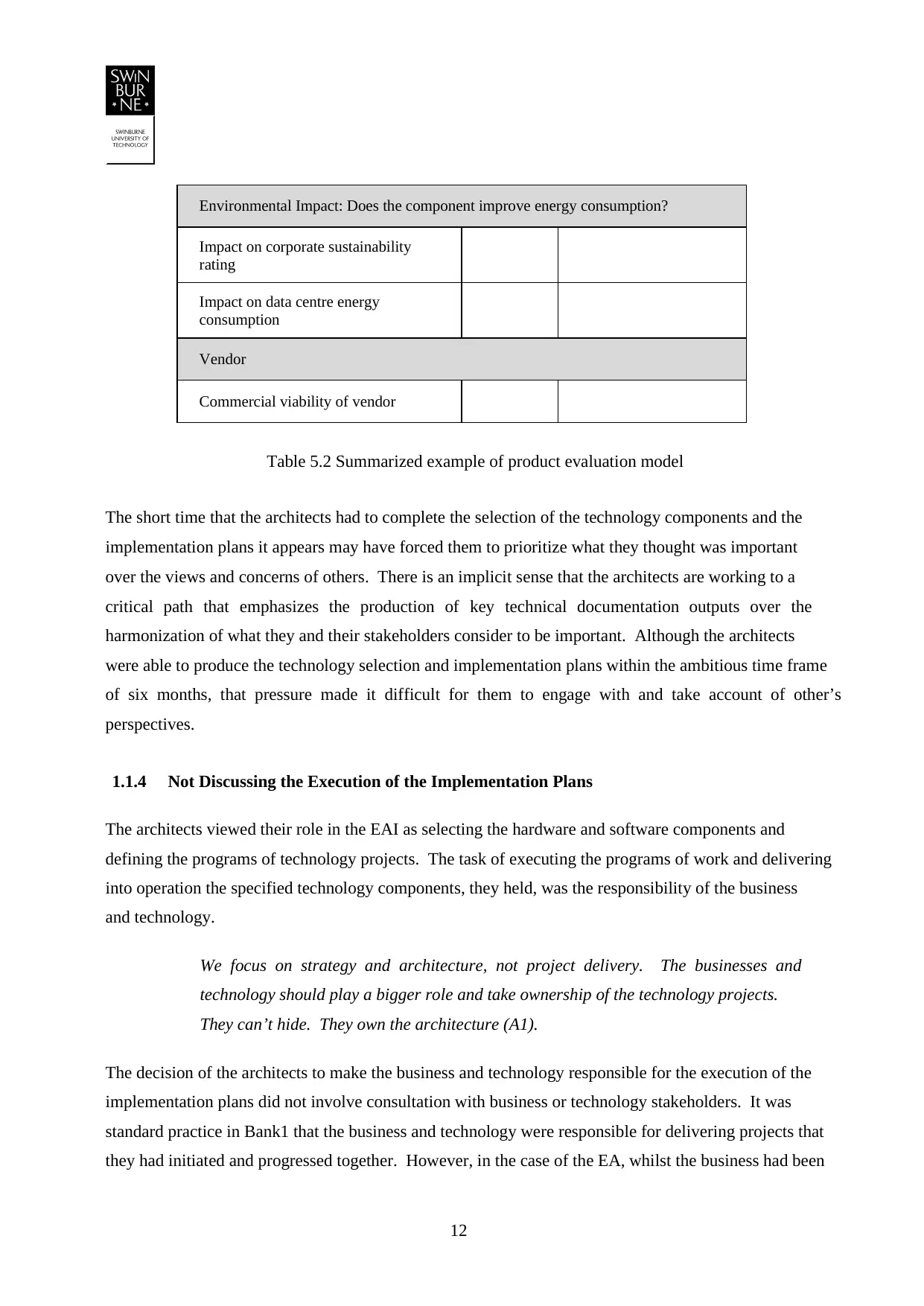
12
Environmental Impact: Does the component improve energy consumption?
Impact on corporate sustainability
rating
Impact on data centre energy
consumption
Vendor
Commercial viability of vendor
Table 5.2 Summarized example of product evaluation model
The short time that the architects had to complete the selection of the technology components and the
implementation plans it appears may have forced them to prioritize what they thought was important
over the views and concerns of others. There is an implicit sense that the architects are working to a
critical path that emphasizes the production of key technical documentation outputs over the
harmonization of what they and their stakeholders consider to be important. Although the architects
were able to produce the technology selection and implementation plans within the ambitious time frame
of six months, that pressure made it difficult for them to engage with and take account of other’s
perspectives.
1.1.4 Not Discussing the Execution of the Implementation Plans
The architects viewed their role in the EAI as selecting the hardware and software components and
defining the programs of technology projects. The task of executing the programs of work and delivering
into operation the specified technology components, they held, was the responsibility of the business
and technology.
We focus on strategy and architecture, not project delivery. The businesses and
technology should play a bigger role and take ownership of the technology projects.
They can’t hide. They own the architecture (A1).
The decision of the architects to make the business and technology responsible for the execution of the
implementation plans did not involve consultation with business or technology stakeholders. It was
standard practice in Bank1 that the business and technology were responsible for delivering projects that
they had initiated and progressed together. However, in the case of the EA, whilst the business had been
Environmental Impact: Does the component improve energy consumption?
Impact on corporate sustainability
rating
Impact on data centre energy
consumption
Vendor
Commercial viability of vendor
Table 5.2 Summarized example of product evaluation model
The short time that the architects had to complete the selection of the technology components and the
implementation plans it appears may have forced them to prioritize what they thought was important
over the views and concerns of others. There is an implicit sense that the architects are working to a
critical path that emphasizes the production of key technical documentation outputs over the
harmonization of what they and their stakeholders consider to be important. Although the architects
were able to produce the technology selection and implementation plans within the ambitious time frame
of six months, that pressure made it difficult for them to engage with and take account of other’s
perspectives.
1.1.4 Not Discussing the Execution of the Implementation Plans
The architects viewed their role in the EAI as selecting the hardware and software components and
defining the programs of technology projects. The task of executing the programs of work and delivering
into operation the specified technology components, they held, was the responsibility of the business
and technology.
We focus on strategy and architecture, not project delivery. The businesses and
technology should play a bigger role and take ownership of the technology projects.
They can’t hide. They own the architecture (A1).
The decision of the architects to make the business and technology responsible for the execution of the
implementation plans did not involve consultation with business or technology stakeholders. It was
standard practice in Bank1 that the business and technology were responsible for delivering projects that
they had initiated and progressed together. However, in the case of the EA, whilst the business had been
⊘ This is a preview!⊘
Do you want full access?
Subscribe today to unlock all pages.

Trusted by 1+ million students worldwide
1 out of 31
Related Documents
Your All-in-One AI-Powered Toolkit for Academic Success.
+13062052269
info@desklib.com
Available 24*7 on WhatsApp / Email
![[object Object]](/_next/static/media/star-bottom.7253800d.svg)
Unlock your academic potential
Copyright © 2020–2025 A2Z Services. All Rights Reserved. Developed and managed by ZUCOL.




